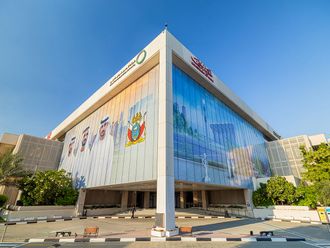The Dubai Design District (or d3) was the only office cluster to actually record a marginal rise in rents over the last 12 months.
Styled as an all-in-one hub for the designer and fashion set and located on Al Khail Road, rents there now average Dh165-Dh170 a square foot, according to Core, the real estate consultancy.
And of the offices currently open there, overall occupancy levels are at around 90 per cent.
As against d3’s gains, just about every premium (non-free zone) office location in the city recorded a dip in asking rents from what they were a year ago. Chances are the decline will continue as the authorities and the many free zones rework the cost of doing business in Dubai.
Costliest offices
The costlist offices still remain those in the DIFC district, at just under Dh250 a square foot.
“Going forward, market sentiment is expected to improve given the implementation of various policy initiatives to reduce business costs and streamline processes, such as Dubai Municipality reducing market fees for businesses from 5 per cent to 2.5 per cent of annual rent,” said Joel McQueen, Head of Commercial at Core.
“A number of free zone authorities have introduced “dual licensing” capabilities, allowing companies to be registered in both off-shore as well as onshore jurisdictions, while also reducing fees and charges to attract new business.”
DAFZA (Dubai Airport Free Zone Authority) has dropped the registration, license and staff visa fees for new investors by 65, 33 and 20 per cent.
The level of effort involved in finding and retaining tenants will be far more intense as more Grade A offices get delivered by early 2020. The arrival of new stock has already shifted rental dynamics in key locations.
“Downtown Dubai, in particular, will see an increase in secondary stock vacancy levels due to Marriot International’s move from Emaar Square to Central Park Towers DIFC, and HSBC’s relocation from Emaar Square to its new built to suit office building,” Core says in its new report.
“New additions to Dubai’s office market supply this year are largely concentrated in the Grade A segment. These additions are expected to alleviate some of the pressure seen in prime office districts, which currently see prohibitively high rents due to limited supply.
“Prior to completion, The Exchange DIFC has been 100 per cent pre-leased by several large occupiers including Nasdaq Dubai, indicating new supply will absorb steadily.”
The emphasis, rightly, should be on steady absorption rates.
If that continues, developers of new offices need not worry too much about too much new stock coming into the market at more or less the same time and without any leases signed for them.
Room to negotiate rents
More also means tenants have more room to negotiate rents to levels closer to what they are comfortable with. The Core market update confirms as much. “With large developments such as ICD Brookfield Place coming onto the market, lease rates are likely to soften in this segment,” it adds.
“Undoubtedly, this signals a positive shift for the market, given supply side expansion will contribute to lowering business operational costs, and increasing the city’s attractiveness for new market entrants.”
Businesses are also in no hurry to conclude lease negotiations. Nearly 30 per cent of the office supply is currently taking one to three months to rent out.
About 20 per cent of the supply has to wait even longer — anywhere between 19 to 24 months to find itself a tenant.
Dubai’s office market adjusts to VAT on rents
The initial months after the VAT introduction from January 1 saw “slightly weaker enquiries and transaction volumes”, according to the Core report. But the implementation has had “marginal impact” - “The effect of VAT was mostly absorbed, as landlords and tenants adjusted to the administrative requirements of tax,” the report notes. “The absorption of VAT by the market was most likely accelerated as any increases in business costs were levelled off by a decline in rents.”
The city’s free zones duel it out
Free zones are busy rolling out all sorts of incentives and ensuring “barriers to entry based on the sector are increasingly blurred”. “Free zones now are offering very competitive licensing structures with many giving an option of dual licensing. We have also seen 100 per cent ownership to foreign investors in some specific onshore business sectors, for example, Apple.”











